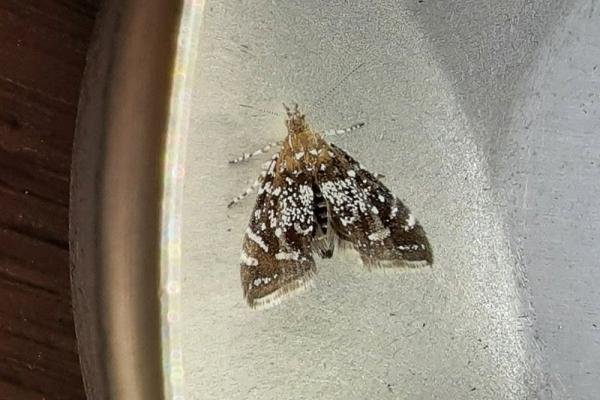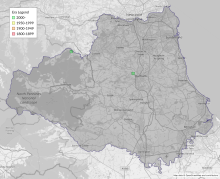Prochoreutis myllerana

48.002
Choreutidae
Choreutinae
Prochoreutis
Nationally Scarce B
Species account (old)
The only record for this species is that of Sang for 5-8-1874 when he found caterpillars at Hell Kettles in vc 66. [...]
Statistics
| Records | 2 |
|---|---|
| Individuals | 2 |
| Largest Sample | 1 |
| First Recorded | 2021 |
| Last Recorded | 2021 |
| Earliest Adult Record | 19/08 |
| Latest Adult Record | 19/08 |
| Monad Coverage | 0.1% |
| Hexad Coverage | 4.8% |
Reports
On the 21st of July 2021 at Malton near Lanchester a micro moth (around 5mm long) came to my clearwing moth lure (FOR) which was unusual enough for me to take notice of. A check with the Field Guide to the Micro Moths of Great Britain and Ireland (Sterling & Parsons, 2012) showed it to be one of two Prochoreutis species either Prochoreutis myllerana or Prochoreutis sehestediana, on first comparing the moth and the field guide illustration I favoured the former. Distribution maps showed only one record of P. myllerana in Durham […]. P. sehestediana was not recorded anywhere in the north of England. The historical Durham record was from the noted Darlington lepidopterist John Sang; he recorded the caterpillars of P. myllerana at Hell Kettles ponds south of Darlington in 1874 (NZ281109). Prior to 1939 however, the two species were not specifically differentiated and were recorded as P. myllerana. It is not possible to differentiate between the species caterpillars, consequently it is impossible to say which species Sang found. Indeed, looking at illustrations and on-line images it was clear that differentiating the two moth species by sight was going to be difficult.
The field guide states that the caterpillars of both species feed on Skullcap Scutellaria galericulata (uncommon in Durham) or Small Skullcap Scutellaria minor (rare in Durham) both are plants of wet habitats. Skullcap does grow at Malton, so a check was made to see if there were any other signs of Prochoreutis sp. presence. Inspection of the plants found typical curled and eaten leaves and eventually both caterpillars and imagoes were found. The Botanical Society of the British Isles provided a list of locations in County Durham where the food plants had been recorded since 2000 and a search was made at nine of the eighteen sites on the list. Skullcap was found at five of the sites, including Malton. All five locations where Skullcap was found showed presence of Prochoreutis species[;] there were no indications of the presence of the moth on Small Skullcap. Eventually moths were seen at all five of the Skullcap sites and specimens were photographed and collected. Indeed, imagoes proved easy to see with their short zig zag flights around the food plant on sunny days through to early September. On one occasion two were seen at Malton nectaring on Angelica (Angelica sylvestris).
In discussions with the current and former County Durham moth recorders Tim Barker and Keith Dover it was clear that identifying which species it was either visually or from a photograph was going to be difficult if not impossible. It was possible to hazard an identification from well marked specimens, but most were not clearly marked and for a species record for the county to be accepted genitalia dissection would therefore be required. To this end seven specimens from the five sites were sent to Tony Davis of Butterfly Conservation who conducted the genitalia examination. The first moth from the pheromone trap in July which I thought was P. myllerana turned out to be a female P. sehestediana proving how difficult visual identification is for these species. The genitalia examination results showed that both species are present in the county, with P. myllerana recorded from two of the five sites and P. sehestediana from three. At no site were both species recorded although the field guide state that this is possible. To clarify if both species are present at some or all the five sites a much larger sample would be required, however given the small number of moths seen at most sites this seems undesirable.
The way to find either species is first to find the food plant. Curled leaves, caterpillar feeding damage and the imago are quite easy to see if present. Skullcap is an uncommon plant in the county which can be found in wet woodlands, fens, and pond margins all of which are declining habitats, the rarity of the moths a product of the rarity of the plant. A search for skullcap between June and September in 2022 could provide more locations for both species […]. […] There may well be other wetland locations where skullcap can be found and the BSBI recorder would welcome confirmation and a grid reference for any of the known sites and any new skullcap records. Similarly, the County Durham moth recorder would welcome any further records for Prochoreutis species.

Map
This map shows all records of Prochoreutis myllerana in the Durham (VC66) database per monad (1km grid square). The map can be explored further by zooming and panning, can be reset using the button on the left, and can be filtered by selecting the era. Click on a monad to view a full list of species recorded in it, or its containing hexad (10km grid square).

Week graph
This graph shows the County Durham (VC66) records of Prochoreutis myllerana per 7-day period, differentiated by life stage. Hover over/tap the graph to see an exact count of records at that point in time. Hover over/hold the life stage legend to highlight a particular life stage; click on a life stage label to remove it from the graph. The graph can be filtered further by selecting the era.
The graphs below show the total records and individuals of Prochoreutis myllerana in County Durham (VC66) per time period. Hover over/tap the graph to see an exact number of records and individuals at a particular point in time. Hover over/hold a label to highlight a particular metric; click on a metric label to remove it from the graph.
Era graph
Year graph

Gallery
This gallery shows images of Prochoreutis myllerana. Clicking on a photo opens it in a large lightbox with a full caption, and the arrow buttons move between photos. If you would like to contribute any photographs, particularly of any stages not captured here, please email admin@durhammoths.org. Most photos on this website have been taken by County Durham (VC66) recorders, but please note that not all have been taken in the county.

Foodplants
This is a list of foodplants known to be used by the larval stages of Prochoreutis myllerana in the UK.
Habitats
There are no habitats listed for Prochoreutis myllerana.
Foodplant information derived from Padovani, R.; Ward, L.; Smith, R.M.; Pocock, M.J.O.; Roy, D.B. (2020). Insect species richness for each plant species and insect-plant interactions from the Database of Insects and their Food Plants [DBIF] version 2. NERC Environmental Information Data Centre. https://doi.org/10.5285/33a825f3-27cb-4b39-b59c-0f8182e8e2e4

